Shooting landscapes is something everyone has done. It’s wherever you happen to be. The mountains, the forests, the prairies and the coasts of Canada, all provide unique backdrops for photographers to express their creativity. I have found that it isn’t necessary to drive for hours or to travel to the farthest corners of the planet to get unique and interesting photos. Quite the contrary, I believe the best landscapes are the ones close to home.
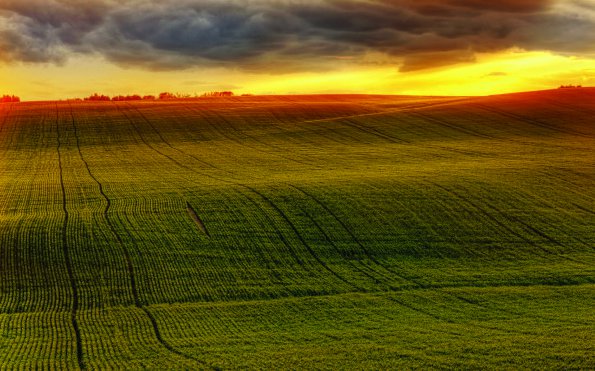 |
| A fire orange sunset over an early summer crop of wheat. The rows in the wheat accentuate the rolling hills and give it added dimension. © Dan Jurak |
I happen to live in the middle of the Alberta prairie. Many Albertans would think of the Rockies if they wanted to capture interesting landscapes, but it’s not necessarily so.
I have come to appreciate the unique beauty of our flatlands. What you see here can’t be captured on either coast, or in the national parks. Of course, the Parks are beautiful, but I can’t be there every day to catch the subtle changes of the seasons.
The same can be said for wherever you live. Whether it’s the lakelands of Ontario or the coast of Newfoundland, the best landscapes are only moments away. By shooting where you live, you can observe the land changing in ways that the casual visitor can’t imagine.
What I do when shooting landscape images is applicable to anyone, anywhere. It’s not so much about the terrain – it is more about the weather and the light. Your daily access to changing weather in your area is one of the keys to your success as a landscape artist.
The most striking landscape vista is more than a study of scenery – it is the act of capturing a moment in time. A passing storm, an unusual sunset or a foggy morning; all can turn the most ordinary of places into something special. For me, this is the allure of the landscape.
Light, weather and location are, in descending order, the most important parts of a successful landscape photograph.
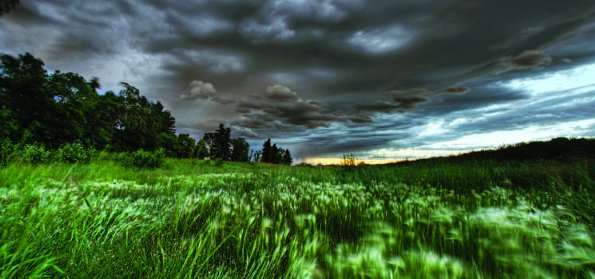 |
| The moment I saw these dark clouds building on the horizon I headed out of town to grab whatever I could. A four second exposure helps reveal the movement of the clouds and the fox tails in the foreground. © Dan Jurak |
Summer is about contrasts in weather. A fast moving storm provides the drama and power to contrast a summer afternoon. Cool morning fog is replaced by scorching afternoons. That being said, mornings are my favourite time to be driving on backcountry roads, looking for interesting scenes to capture.
With the sun close to the horizon, everything has more depth. The low light throws shadows across the ground and makes grasses, shrubs and trees more three-dimensional. The same location that looked magical in the early morning will be almost unrecognizable during the middleof the day.
One of the joys of shooting close to home is finding out how beautiful it is where I live. So many people will drive for hours to the mountains or the coast to shoot landscapes when the treasures that we seek are so close by.
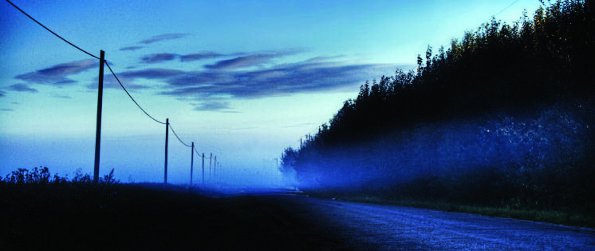 |
| A lonely country road in the middle of no where? Hardly. Taken just minutes out of town, you needn’t travel far to find special places to photograph. © Dan Jurak |
Easily ninety percent of the photos that I take are within twenty kilometers of my back door, and a fair number of “country” scenes are inside the city limits of Edmonton. The same applies to where you live. Use that to your advantage. You have access to your area 24/7, with all of the lighting and weather conditions that make for effective photographs. Venture hours or days away from home to find landscape images, and you have to take the weather that you’re given during your short stay.
I make a habit of checking the weather forecast before I retire for the night. I want to see if there is going to be anythingunusual happening. Will it be clear? Cloudy? Rainy? Some mornings, it’s better to stay home. If it’s going to be gray and overcast, I stay home because the light is too flat, even early in the day. Generally, flat light is not good for wide landscapes, but it is well suited to tight shots where the shadows are soft – if they exist at all.
The forecasts that catch my attention are the ones where the humidity is high, the winds are calm, and the temperature is dropping. Morning fog is almost sure to happen. If there’s a chance of it, I am out the door before the sun is up. A morning of light fog where the sun is burning a hole through it is a photographers dream – everything is transformed into a fantasyland. Flat, uninteresting prairies become almost unrecognizable compared to how they look during mid-day. The world is a very special place when the sun is low and the fog is laying on the land.
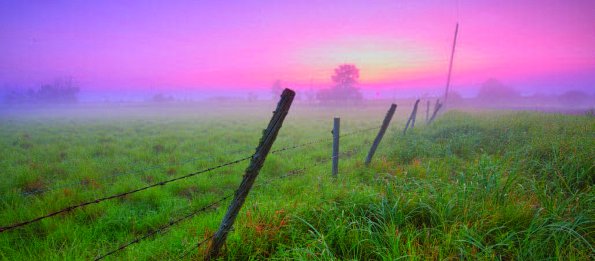 |
| Shooting into the sun no special filters were needed to capture the extreme range of light. A blended image comprised of three bracketed exposures, +2, 0 and -2 EV provided all the information to hold the detail in the sky and shadows. © Dan Jurak |
The subtle nuance of light is also critical for recording the most effective landscape images. The old saying about having the sun at your back might make sense for portraits, but not so much for landscapes.
I often find myself looking towards the sun when composing my landscapes. This can make for better photos, but it presents a few technical problems.
An easier and more elegant solution to recording the increased dynamic range of the scene is to shoot HDR or high dynamic range images. Simply put, you shoot three pictures of the scene – one at the metered exposure, one overexposed and one underexposed, and then combine the three images, taking the highlight and shadow detail from the over and under exposed images and replacing them on the middle exposed image.
It sounds complicated, but it’s not. The technique is actually very simple – I always shoot with a tripod and shutter release. My camera is set to expose three successive frames at a -2 EV, 0 and +2 EV. Everything is shot this way. If I don’t need the extra exposures for my final image, I delete them from my hard drive to save space. Sometimes I will only need the under exposed and normally exposed image to get my working shot.
There are many ways to combine your multiple exposures. The easiest way is through post-processing software, and the program I use for it is Photomatix. This recommendation comes with a caution. Photomatix makes it very easy to get the surrealistic, overblown, halo filled images that have caused many to think that is what all HDR images look like.
In my mind, a good HDR image is one that looks “normal”. No halos. No posterizaton, just a well-exposed, well-lit scene.
As with any program, it takes a bit of practice to find out how to use it properly. Early on, I was bedazzled by the effects that were produced by Photomatrix, and I went overboard with them. I cringe when I look at how I processed those photos.
If mornings don’t pan out, the summer can provide spectacular weather, especially from mid-afternoon to early evening, when it is not unusual to see thunderstorms. I always have my camera gear locked and out of sight in my vehicle should I see a storm approaching on the horizon.
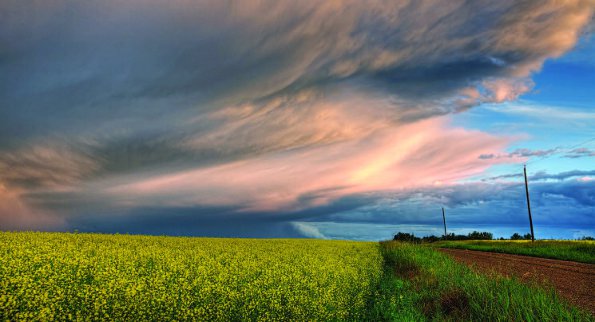 |
| Following a late afternoon storm, the setting sun provides added drama to already powerful looking clouds. The yellow of the ripening canola field contrasts the blue sky on the opposite corner of the frame. © Dan Jurak |
The most visually interesting part of a storm is the weather front as it moves through your area. I have often caught storms blowing by, and I try to take a few pictures of the cloud formations at the front, then I get back in the vehicle and drive ahead of the storm, stop, and rephotograph them again and again. You have to stay just ahead of the weather – as soon as the storm front passes over you, it is either raining or the sky has turned totally gray which doesn’t work well in pictures.
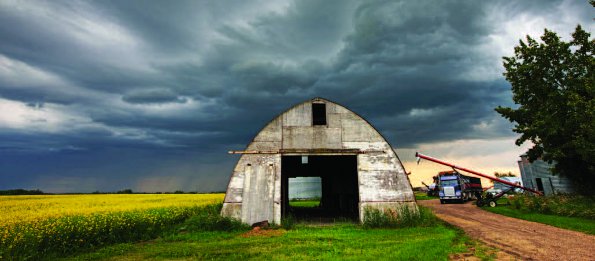 |
| Unusual weather can turn the ordinary into the extraordinary. When most sane people are inside staying out of the bad weather, I’m outside chasing it. These are ethereal skies. Here one moment and gone the next. © Dan Jurak |
The contrast of a mile high wall of clouds against blue sky can be impressive, and often the winds pick up, adding motion to trees and grasses giving your pictures an impressionistic look. Your photographer’s reflexes are important during these moments – you have to act fast, because in a matter of minutes the best photo opportunity is over. Learn to compose quickly and shoot, shoot, shoot. If you don’t shoot it, it’s lost forever. These aren’t the days of film where every exposure cost you money. Take advantage of that.
When I chase these storms, I always look for some kind of foreground to reference the sky with. Most often it is a fence post, sometimes it can be a barn or quonset or an old vehicle. My eyes are always scanning the sky and horizon for a good match.
The more predictable and easier time of the day to shoot is the evening. You can plan a little bit ahead to find a suitable location. Fifteen or twenty minutes before the sun is about to set, you can get a fair impression of how the skies will look and what will make an interesting foreground.
Because I usually shoot close to home, I have an idea of where the trees might look interesting. There could be an old granary that is falling down or a farm dugout that can provide reflections to a late summer evening sky.
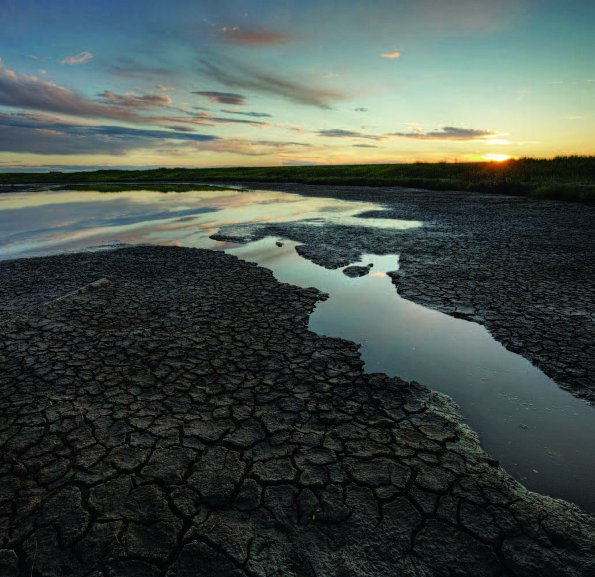 |
| The sun was just setting below the horizon when I planted the tripod on the cracked mud shoreline of a farm dugout. A wide angle lens placed close to the ground helps provide an interesting perspective. © Dan Jurak |
Familiarity with an area is asset when the light is changing quickly. In a few minutes the light you were looking for could be gone. That is part of the allure and the reward of shooting close to home.
The same places can look so different depending on the time of day or the time of year. It’s always a challenge and one that I am always looking forward to.
Spend some time getting to know the area where you live. You will come back with more interesting photos than you could ever imagine, and you might wonder how you could have missed them before.
Article by Dan Jurak
| PHOTONews on Facebook | PHOTONews on Twitter |







